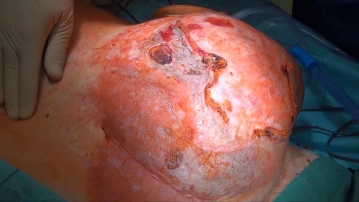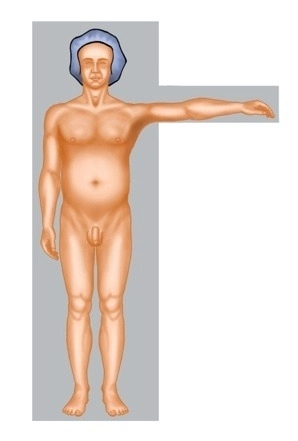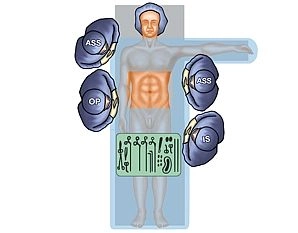The reconstruction of the abdominal wall in complex incisional hernias or the presence of a laparostoma presents a particular challenge. A "loss of domain" represents the extreme form of a volume shift of the intestines.
Complex hernias are considered abdominal wall hernias with defect widths of more than 10 cm, recurrent incisional hernias after mesh implantation (mesh edge herniation, mesh tear, mesh rupture), hernias after flap transfer (denervation, donor site defects), and multiple recurrences.
In principle, the indication for repair of even a complex hernia is given. Patients lack ventral stabilizing elements of the trunk musculature. Patients with such unstable abdominal walls complain of postural problems with back pain. Physically demanding activities and sports are severely restricted to impossible. An intact ventral abdominal wall is of great importance for physiological processes such as breathing and defecation.
Furthermore, the abdominal wall defect and the extra-abdominal organ volume will continue to increase. The reconstruction of the abdominal wall ultimately occurs to prevent increasing morbidity.
The problem with these complex cases is the retraction of the lateral abdominal musculature. The tension towards the midline can be significantly reduced by a length gain of the lateral abdominal musculature.
There are various techniques for this measure to regain muscle length on the lateral abdominal wall
- Abdominal wall relaxation with BTA (preoperative iatrogenic, temporary paralysis of the lateral abdominal musculature with botulinum toxin)
- Progressive pneumoperitoneum (abdominal wall dilation through a preoperative pneumoperitoneum)
- Intraoperative fascial retraction (traction of the abdominal wall under pharmacological relaxation) see also special preparation
In the demonstrated case after median laparotomy with sigmoid resection and creation of an end colostomy (Hartmann's situation), a parastomal hernia occurred. Multiple external therapy attempts, most recently with the implantation of a synthetic mesh in onlay technique, led to a progressive incisional hernia recurrence with skin ulceration and partial exposure of the mesh.
After conditioning the abdominal wall in this case through pneumatic pre-dilation (see abdominal wall reconstruction after Ramirez / Perioperative Management) a renewed hernia repair was performed using the technique described here. The AP relocation offered to the patient with reconnection of the colon was declined.
Additionally, an abdominal wall component separation was required to achieve a fascial closure in the midline.
With the anterior component separation ("Ramirez") presented here, midline defects with a width of up to 20 cm periumbilically, up to 8 cm epigastrically, and up to 6 cm suprapubically can be closed by separating parts of the lateral abdominal wall. The technique allows for a tension-free closure with a dynamically competent abdominal wall.
Due to the extensive detachment of the subcutaneous tissue with the risk of destroying perforating vessels (blood supply to subcutaneous tissue and skin through the deep epigastric vessels) and the resulting high rate of wound healing disorders, hematomas, and seromas, this technique is now considered a second-choice procedure. The posterior component separation, which leads to a release in the area of the transversus muscle, is favored; additionally, the mesh bed can be expanded laterally, dorsally, and retrocostally.
The reconstruction according to Ramirez was described in the original work without mesh augmentation. The results in the literature favor the simultaneous implantation of a retromuscular mesh.
With a permanent end stoma, a closure of the parastomal fascial gap according to Sugarbaker with intraperitoneal mesh placement under lateralization of the intestine was additionally performed.
In infected skin conditions with superficial skin infections and pressure ulcers, biological mesh implants are advantageous and were also used in this situation.




